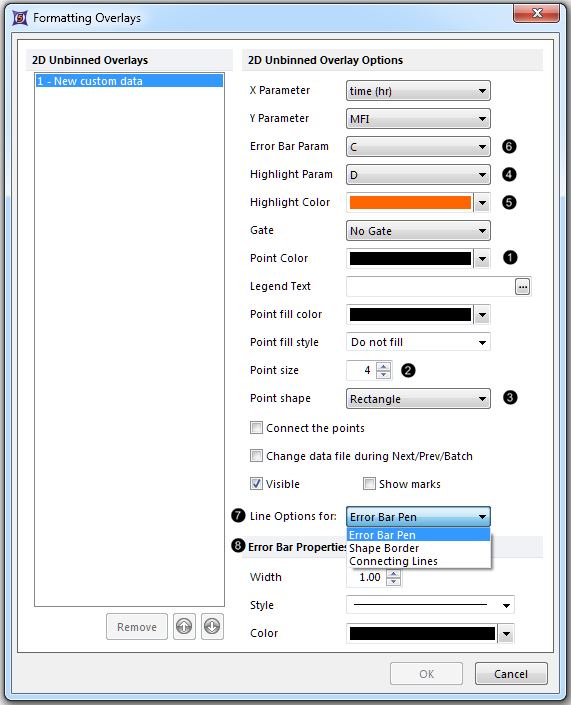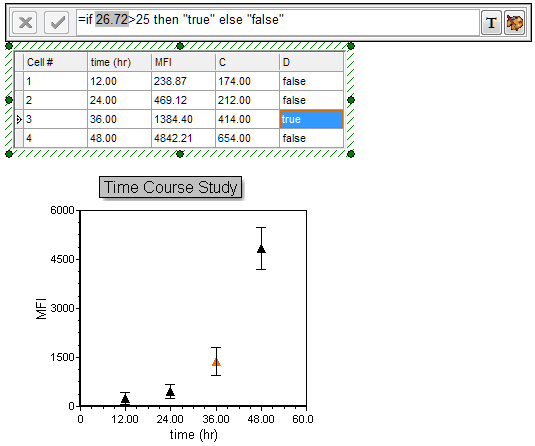Formatting Scatter Plots
Scatter Plots in FCS Express are fully formattable. In addition to the formatting options shared by all plots (e.g., border, size, background, axis, titles, and legend), special formatting options are accessible from the Overlays category. To access these special options, either
| • | Select the Scatter Plot and use the Format tab→Plot Options→Overlays command, or |
| • | Right-click on the Scatter Plot, select Format from the pop-up menu, and choose the Overlays category. |
Special formatting options for Scatter Plots are indicated by number below (Figure 11.47) and include:
| • | Point Color ( |
| • | Point size ( |
| • | Point shape ( |
| • | Highlight Param( |
| • | Highlight Color( |
| • | Error Bar Param ( |

Figure 11.45 Special formatting options for Scatter Plots
The formatting options are described in the table below.
Option |
Explanation |
|---|---|
X Parameter |
The parameter (column) from the Custom Data Grid displayed on the X axis. |
Y Parameter |
The parameter (column) from the Custom Data Grid displayed on the Y axis. |
Error Bar Param. |
The parameter (column) from the Custom Data Grid displayed as error bars. See below for more information on how to define the error bars. |
Highlight Param. |
The parameter (column) from the Custom Data Grid from which the highlighting rule derives. Points will be highlighted (e.g., the orange point in the plot below) in the color defined in |
Highlight Color |
The display color for highlighted points. |
Gate |
The range gate defined on the Custom Data Grid that is applied to the Scatter Plot. |
Point Color |
The display color for points. |
Legend Text |
The text that will appear in the plot legend beside the symbol for the overlay. |
Point size |
The size of the points. |
Point shape |
The shape of the points. Choose between rectangle (default), triangle, circle, cross, star, hexagon, and diamond options. |
Connect the points |
Whether the points are connected by a line. |
Change data file during Next/Prev/Batch |
Whether the Scatter Plot changes during batch processing or in response to a Next/Previous command. It is generally recommended to leave this unchecked (default), as the Scatter Plot will update automatically as the data to which it refers is changed. |
Visible |
Hides overlays without removing them. Select the overlay file from the 2D Unbinned Overlays list and uncheck Visible. Check Visible to show the overlay again. |
Show marks |
Displays the value of the points as text directly above the points. |
Line Options for |
Toggle between Error Bar Pen, Shape Border, and Connecting Lines editing mode. |
Error Bar Pen/Shape Border/Connecting Lines Properties |
Width, Style (solid, dotted, and dashed options), and Color of the Error Bar Pen, Shape Border, or Connecting Lines. |
To add error bars or highlighting to a Scatter Plot, these values must be entered into designated columns in the Custom Data Grid. To access the Custom Data Grid if it has been deleted from the layout, select the View tab→Navigators→Data Navigator command, drag and drop the "New custom data" item onto the layout, choose Data Grid from the Select Plot Types dialog, and click OK.
To define values for the Error Bars,
| 1. | Add a new column to the Data Grid, if no empty columns exist |
| 2. | Optional: rename the empty column "error" |
| 3. | Enter the value of the error for each row (each row corresponds to an individual point). This value may be freetext or a custom token. |
| 4. | Choose the appropriate Custom Data Grid column for the Error Bar Parameter (Figure 11 above, |
An example of a Scatter Plot with Error Bars and its associated Custom Data grid is shown in Figure 11.48 below.
To define a Highlighting rule,
| 1. | Add a new column to the Data Grid, if no empty columns exist |
| 2. | Optional: rename the empty column "highlighting" |
| 3. | Enter the value of the rule for each row (each row corresponds to an individual point). The rule must be a formula evaluating to "TRUE" or "FALSE"; if "TRUE," the point will be highlighted with the color defined in Figure 11 above, |
=if Statistic: % of Gated Cells for Density Plot, Gate 3 > 25 then "true" else "false"
| 4. | Choose the appropriate Custom Data Grid column for the Highlight Param. (Figure 11 above, |
An example of a Scatter Plot with Highlighting and its associated Custom Data grid is shown in Figure 11 below.

Figure 11.46 Scatter Plot and associated Custom Data Grid with Error Bars and Highlighting
Note: Scatter Plot Axis titles are derived from the Custom Data Grid column names.
